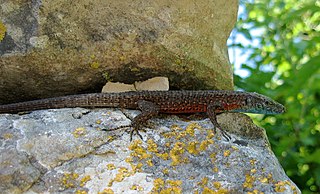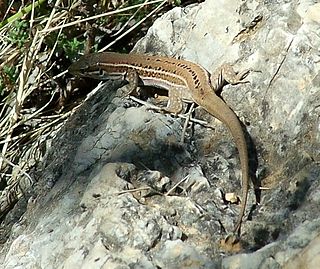
Podarcis is a genus of lizards in the family Lacertidae. Its members look very similar to lizards of the genus Lacerta, to which they were considered to belong until the 1970s. While similar externally and ecologically, Podarcis form a distinct group differing from Lacerta by the construction of the skull and the hemipenis, and by the processes of the caudal vertebrae. They are commonly known as wall lizards. They are native to Europe and northern Africa, and most species are restricted to the Mediterranean region. Wall lizards diversified and hybridized during the Messinian salinity crisis. The Italian wall lizard and the common wall lizard have been introduced to North America, where they have become intermediate hosts for some Acuariidae larvae.

Plestiodon multivirgatus, commonly known as the many-lined skink, the northern many-lined skink, or the variable skink, is a medium-sized species of lizard, a member of the North American skink genus Plestiodon in the family Scincidae. The species is native to the western United States.

Erhard's wall lizard, also commonly called the Aegean wall lizard, is a species of lizard in the family Lacertidae. The species is endemic to Southeast Europe.

The Milos wall lizard is a small Mediterranean lizard.

The Madeiran wall lizard is a species of lizard in the family Lacertidae. It is the only species in the genus Teira. The species is endemic to the Madeira Archipelago, Portugal. In the Azores, this lizard has become naturalized after involuntary introduction by the shipping trade between the two archipelagos. There are four recognized subspecies.

The blue-throated keeled lizard, or Dalmatian algyroides, is a species of lizard in the family Lacertidae.

The Iberian rock lizard is a species of lizard in the family Lacertidae. The species is endemic to Portugal and Spain. Its natural habitats are mountain forests, shrubland, rivers and rocky areas. It is threatened by habitat loss.

Bocage's wall lizard is a species of lizard in the family Lacertidae. The species is endemic to the Iberian Peninsula. Its natural habitats are temperate forests, temperate shrubland, Mediterranean-type shrubby vegetation, sandy shores, rural gardens, and urban areas. The IUCN does not consider it to be threatened.

The filfola lizard or Maltese wall lizard is a species of lizard in the family Lacertidae. It is found in Italy and in the island group of Malta. Its natural habitats are Mediterranean-type shrubby vegetation, rocky areas, rocky shores, arable land, pastureland, and rural gardens.

Lilford's wall lizard is a species of lizard in the family Lacertidae. The species is endemic to the Balearic Islands, Spain.

The Dalmatian wall lizard is a species of lizard in the family Lacertidae. It is found in Albania, Bosnia and Herzegovina, Croatia, Italy, Serbia, Montenegro, and Slovenia. Its natural habitats are temperate forests, Mediterranean-type shrubby vegetation, rocky areas, and pastureland.

The Peloponnese wall lizard is a species of lizard in the family Lacertidae. It is endemic to the Peloponnese region of southern Greece. Its natural habitats are Mediterranean-type shrubby vegetation, rocky areas, arable land, pastureland, plantations, and rural gardens.

The Ibiza wall lizard is a species of lizard in the family Lacertidae. It is most closely associated with the island of Eivissa, or Ibiza, in the Balearic Islands, but has become naturalized in parts of Spain.

The Aeolian wall lizard, also known commonly as Raffone's wall lizard, is a species of lizard in the family Lacertidae. The species is endemic to Italy.

The Sicilian wall lizard is a species of lizard in the family Lacertidae. Endemic to Italy, it occurs in Sicily and the Aegadian Islands. Its natural habitats are temperate forests, temperate shrubland, Mediterranean-type shrubby vegetation, temperate grassland, arable land, pastureland, and rural gardens. The IUCN does not consider it to be a threatened species. Three subspecies are recognized: P. w. antoninoi, P. w. marettimensis, and P. w. waglerianus.

Podarcis tauricus, the Balkan wall lizard, is a common lizard in the family Lacertidae native to south eastern Europe and Asia Minor. It is a terrestrial species found in steppe, grassland, olive groves, cultivated land, meadows, rural gardens, sparsely vegetated sand dunes and scrubby areas.

Podarcis cretensis, the Cretan wall lizard, is a species of lacertid lizard endemic to Crete.


















